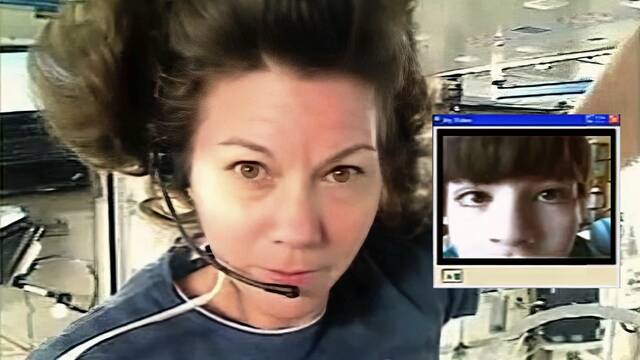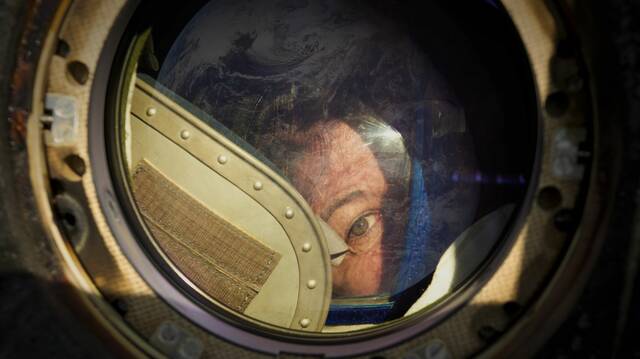TV Talk: Astronaut with Pittsburgh ties appears in ‘The Longest Goodbye’ on PBS
Trib Total Media TV writer Rob Owen offers a viewing tip for the coming week.
PASADENA, Calif. — Retired NASA astronaut Cady Coleman says in PBS’s new “Independent Lens” documentary “Space: The Longest Goodbye” (10-11:30 p.m. May 6, WQED-TV) that even after she’d spent 159 days in space on the International Space Station away from her husband and then-fourth grader son, she would have extended her stay.
“If I could have spent another six months, I would have stayed in a minute,” Coleman says in the film.
But the film begins with another astronaut who says a trip to Mars — six months there six months back, maybe 18 months on the surface in between — isn’t for him.
“I just don’t think I’m cut out for this,” he says.
This dichotomy alone shows two of the thousands of variables in human response to long-duration space flight that “Space: The Longest Goodbye” explores. How will a crew get along? Would virtual reality be helpful for extended missions? What effect would three-years in space have on the human body?
In the film and in her upcoming book, “Sharing Space: An Astronaut’s Guide to Mission, Wonder, and Making Change” (on sale July 2 from Penguin Life, $28), Coleman describes a mission-first approach to her career and life.
“I think there’s this sentiment that it must be so grueling and so hard that you would want to come home as soon as you could,” Coleman said during an “Independent Lens” press conference as part of PBS’s portion of the winter 2024 Television Critics Association press tour. “There’s a statement at the beginning of the movie where they say, ‘I’m counting the days.’ I forgot to count the days. It just never occurred to me to count the days. And one of the things that was so real for me up there was that once you’re up there, after a month or so you get really good at doing what you’re supposed to do. All these experiments and the timeline and some of the other extra things that you do, I just wanted to get more of that done.”
Coleman is the sister of Fox Chapel’s James Murray- Coleman, director of sustainability at Trammell Crow, a Pittsburgh commercial real estate developer. In the ’90s, Murray-Coleman worked in real estate development for the Pittsburgh Cultural Trust. Cady Coleman’s nephews, Garrett, Kieran and Conor Coleman are world-class Irish dancers. Garrett was the Irish and Hammerstep choreographer for and a dancer in the 2022 Broadway musical “Paradise Square” which Conor also danced in.
With her Pittsburgh ties, Cady Coleman even cheered on the Steelers in Super Bowl XLV from space. During her six-month mission, astronauts got to have three video conferences with family or friends. For one of hers, Coleman-Murray arranged for his sister to talk with Girls of Steel, a Carnegie Mellon-associated all-girl robotics team that was in its infancy at the time. Cady Coleman later met with the group after her mission.
“The Longest Goodbye” shows Coleman’s video chats with her son, Jamey Simpson, including one where Coleman’s husband says Jamey has been rude to his grandmother. When Jamey comes on screen, Coleman gives him “a mom look.”
“I cried when I saw that clip,” Coleman said. “And I’ve seen it a lot of times but it brings back that you just can’t be there. You can’t do all the things you might do differently. Or even just be there for that kid that clearly just needs a hug.”
For 26 years, including the three years she trained for her 2011 ISS mission, Coleman commuted between the Johnson Space Center facility in Houston, Texas, and her home in western Massachusetts.
“We were pretty determined to find ways to stay in touch and be present, which I think really paid off (when I was) on the (space) station,” Coleman said, noting she read stories to Jamey at his bedtime, and they had a special way they said goodnight.
“When she was on station, the way that we would say good night is she would call just after our dinnertime on the East Coast,” Jamey Simpson explained. “And as she would call from her satellite phone, she would call our landline at home. And we would run out to the porch, and we could see (the space station) arcing across the sky. We’re talking to her on the phone, and it’s incredible to think that that little pinpoint of light going across the sky is somebody that you love, no less, your mother.”
Simpson, now a 23-year-old American University journalism grad who works as a freelance photographer based in Washington, D.C., said even as a child he mostly understood when his mom had to be away from home.
“From a very young age, I realized the importance of what my mom was doing up there, and that for me to get frustrated about her missing my band recital or baseball practice or whatever, it was completely out of the question,” he said, “because the work that she’s doing up there is benefiting so many people down on Earth. There was no room for me to be upset with my mom. But on the other hand, that sort of anger of being frustrated that my mom was gone for so long, it manifested itself in the people around me, and unfortunately, I took it out on my grandma at the time.”
Coleman said she sees “The Longest Goodbye” as an important film, particularly as NASA aims for a return to the moon and an eventual crewed mission to Mars.
“It puts the human into human space flight,” she said. “It puts the human into very hard endeavors, of which we have many that are just simply earthbound. And somehow, when you talk about something like this that happens in space, it makes people pay attention, and it draws them to it.”
You can reach TV writer Rob Owen at rowen@triblive.com or 412-380-8559. Follow @RobOwenTV on Threads, X, Bluesky and Facebook. Ask TV questions by email or phone. Please include your first name and location.
Remove the ads from your TribLIVE reading experience but still support the journalists who create the content with TribLIVE Ad-Free.



